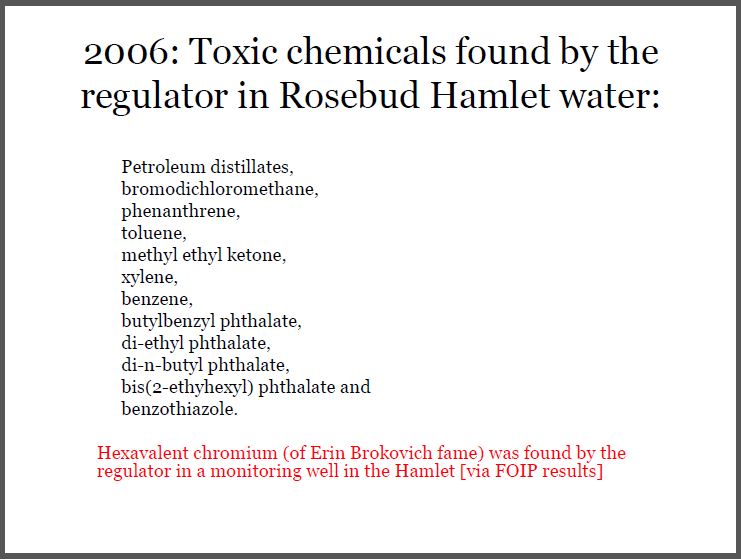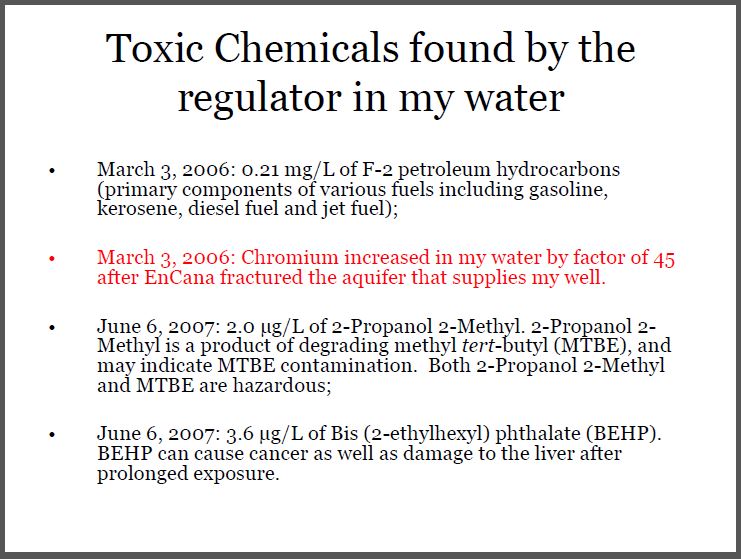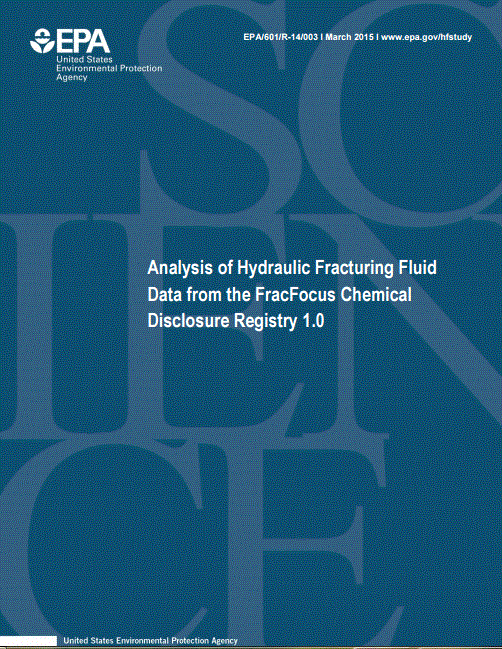“The project database contains 692 unique ingredients reported for additives, base fluids, and proppants. Operators designated 11% of all ingredient records as confidential business information. One or more ingredients were claimed confidential in more than 70% of disclosures.”
A message from TXsharon at BLue Daze
EPA releases first part of frack study, an analysis of chemical disclosure by Susan Phillips, March 27, 2015, State Impact
The Environmental Protection Agency released an analysis of frack water on Friday, based on data that drillers supplied to the website FracFocus. The EPA’s report is just one part of the agency’s long awaited fracking study, which will assess the impacts of hydraulic fracturing on drinking water supplies. The full report is due out this spring.
…
“While these maximum concentrations [of chemical additives] are low percentages of the overall fracturing fluid,” said Burke, “more than half the wells had water volumes greater than 1.5 million gallons. So a small percentage may mean hundreds or thousands of gallons of chemicals could be transported to, and present on, the well pad prior to mixing on the fracking fluid. Remember one percent of a million gallons is a large number — 10,000 gallons.”
The three top chemicals used in the frack fluid were hydrochloric acid, methanol, and hydro-treated light petroleum distillates. Hydrochloric acid is used to keep the well casings free of mineral build-ups, while methanol is used to increase viscosity. Petroleum distillates are refined products like diesel, kerosene, or fuel oil, and are used to make the fluid “slick,” or soapy, and thereby reduce friction.



Photo: Pallets of petroleum distillates on Encana lease just north of Rosebud in 2006. Above slides from Ernst presentations
Producers have steered away from using distillates in their fracking fluids in recent years to avoid stricter federal regulations. … [Diesel] moves quickly through water, and even small amounts of the neurotoxins within the liquid fuel cause liver and kidney damage.
The agency analyzed the information provided to FracFocus for a two-year time frame stretching from January, 2011 to February, 2013. During that time, the reports show that drillers in Pennsylvania used about 11 billion gallons of water to frack 2,483 wells.
With funding from industry trade groups, FracFocus launched in April 2011 as an optional disclosure tool. The effort was a response to criticism regarding industry exemptions from several federal environmental regulations, which would have required chemical disclosure, among other things. More than 200 operators voluntarily uploaded their fracking fluid recipes for each well – with the exception of those ingredients companies deemed “trade secrets.”
FracFocus is run by the Interstate Oil and Gas Compact Commission and the Groundwater Protection Council, both based in Oklahoma City. The IOGCC is a multi-state government agency and the GWPC is a[n industry controlled] group of state regulators who oversee water quality and oil and gas development. Pennsylvania is a member of both organizations.
Jeanne Briskin, coordinator for the EPA’s frack study, praised both the Groundwater Protection Council and the IOGCC for their cooperation. A recent report by Inside Climate News revealed that the EPA’s fracking study has been stymied by industry players who have thwarted efforts to collect good data.
“This is one source of data to help us understand the frequency of chemical use, and the amounts of water used,” said Briskin. But the report also has limitations. Tom Burke told reporters that the information is underestimated due to the fact that not all states required companies to report their water and chemical usage, and industry could refrain from reporting anything it deemed a “trade secret.”
Seventy percent of all well reports included at least one undisclosed entry due to trade secret claims.
Kim McEvoy of Butler County is among the people who believe gas drilling ruined their drinking water. StateImpact has reported on the difficulties associated with how FracFocus makes their data available to the public. Each report is in a PDF file, which makes it difficult to do any type of analysis. PDFs are not “machine-readable.” In other words, computers can’t understand the documents, so it’s harder to tell machines to pull the data out and organize the information as a table or a spreadsheet. (An Excel spreadsheet is one example of a “machine-readable” document.)
… The EPA would not answer questions on the toxicity of the chemicals listed, but said that analysis would be forthcoming along with the broader report due out within the next couple of months. [Emphasis added]
Most Drillers Keep Chemicals Secret in FracFocus, EPA Says by Mark Drajem, March 27, 2015, Bloomberg
The EPA scoured filings on the industry-backed FracFocus online registry and found 11 percent of ingredients used in fracking were deemed a business secret and not disclosed. The EPA said Friday 70 percent of wells examined used at least one chemical that was unidentified.
“The fracking industry is hiding a lot of information about the chemicals they are using in our communities,” Kate Kiely, a spokeswoman for the Natural Resources Defense Council, said of the findings. “Even without that information, it is clear that there is widespread use of dangerous chemicals.”
FracFocus has gained new importance because a rule for fracking on federal lands, released this month, requires drillers to use it to inform the public about the chemical ingredients. Environmental groups complain that the site is cumbersome and gives companies too much leeway to claim confidentiality. …
Drilling-service companies say they should, for competitive reasons, be permitted to keep some of their recipe and ingredients secret.
… Chemicals used include hydrochloric acid, methanol, ethylene glycol, guar gum and napthalene, according to the report.
The EPA analyzed statements companies posted on FracFocus from early 2011 to early 2013 as part of its study. The agency had to compile the individual records in the website into a database and then analyze the results. It didn’t study the dangers individual chemicals may pose to human health or the environment. “As part of our broader assessment, we will focus on toxicity,” said Tom Burke, an official in EPA’s office of research. The amount of chemicals identified by EPA might not reflect the full amount because not all states require disclosure to FracFocus, he said. [Emphasis added]
EPA: Nearly 700 chemicals used in fracking by Timothy Cama, March 27, 2015, The Hill
The EPA’s analysis was based on more than two years of data from FracFocus, an industry-backed website that fracking companies in 20 states must use to publicly disclose the chemicals they inject into wells.
The EPA’s researchers analyzed more than 30,000 disclosures from fracking operations.
Hydrochloric acid, methanol, and hydrotreated light petroleum distillates were the most common additives the EPA found. They were reported in 65 percent of the disclosures.
The median number of chemical additives per fracking job was 14, EPA said.
…
Researchers also found that fracking can be a water-intensive operation. The files the EPA analyzed found that each well required between 30,000 and 7.2 million gallons of water.
And, because of the limits of FracFocus, such as the states that do not use it and frackers’ ability to keep certain chemicals confidential, Burke warned that the EPA could be missing a lot.
“We think that the information on chemicals, proppants and cumulative water volumes from FracFocus 1.0 may actually be an underestimate of what’s actually used in the United States during this time period because not all states are actually required to report chemicals,” he said. [Emphasis added]

EPA Analysis of FracFocus 1.0 Data March 2015
The EPA is releasing its analysis of over two years of data provided by the Ground Water Protection Council (GWPC) and the Interstate Oil and Gas Compact Commission (IOGCC) from the FracFocus Chemical Disclosure Registry 1.0. Through this analysis, EPA was able to understand the chemicals most frequently reported in the FracFocus 1.0 between January 1, 2011, and February 28, 2013. In addition to the report, EPA has made the underlying data summarized in the report available to the public as a database with an accompanying Data Management and Quality Assessment Report that assists users who would like to reproduce the work, better understand EPA’s methods, or perform their own analysis.
The EPA will also release state-level summaries of the data found in the FracFocus 1.0 disclosures for the 20 states where operators indicated oil and gas production wells were hydraulically fractured. The state summaries present the total volume of water reported for hydraulic fracturing in each state and the names, frequency of reporting, and the concentrations of the additive ingredients reported to FracFocus 1.0. Well locations were reported in the following states for the study time period: AL, AK, AR, CA, CO, KS, LA, MI, MS, MT, ND, NM, OH, OK, PA, TX, UT, VA, WV and WY.
Releasing the reports, state-level summaries, and project database is another step in EPA’s effort to be transparent and help inform decision-makers. Data from the FracFocus 1.0 Data Analysis will be combined with information from the best available scientific literature and material submitted by stakeholders through the EPA’s technical outreach activities to answer key scientific questions in the EPA’s draft Assessment of the Potential Impacts of Hydraulic Fracturing for Oil and Gas on Drinking Water Resources.
Regards,
Lisa Matthews
US EPA Office of Research and Development
202-564-6669
email hidden; JavaScript is required
[Refer also to:
2014 08 19: FracFocus is a fraud
NEB said Tuesday energy companies are asked to submit information ranging from trade names, purpose and ingredients to the FracFocus.ca website.
2010: Natural Gas Operations from a Public Health Perspective
For many years, drillers have insisted that they do not use toxic chemicals to drill for gas, only guar gum, mud, and sand. While much attention is being given to chemicals used during fracking, our findings indicate that drilling chemicals can be equally, if not more dangerous. ]


